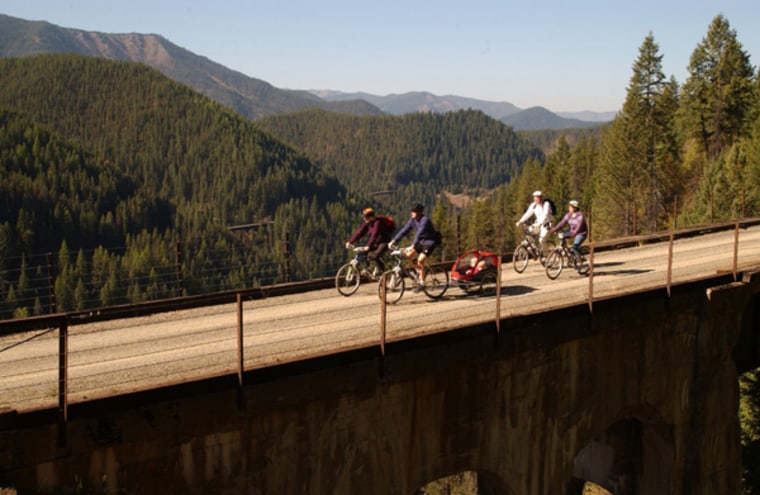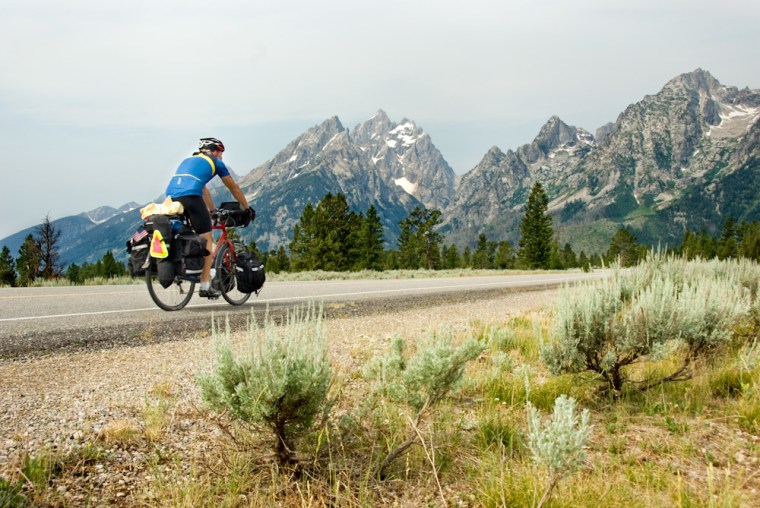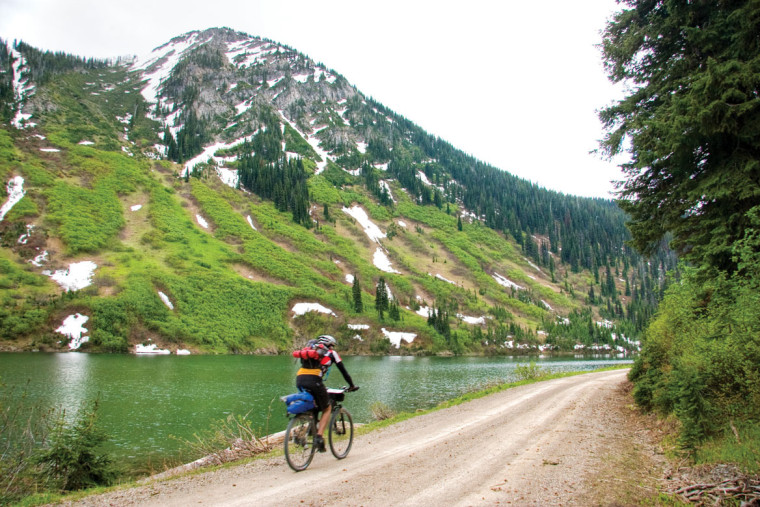Bicycling has come a long way since you pedaled the old neighborhood on your Sting Ray with the sissy bar and purple banana seat.
Just as you eventually graduated to a 10-speed, road bikes have evolved significantly, and then there’s the highly popular category of mountain biking, which combines the pleasures (and pain) of road trips with the yee-haw attitude of wilderness adventure.
Whether you choose a mountain bike or a road bike, isn’t it time for you to venture outside of the neighborhood and take on some of the terrific bike trails scattered across the nation?
From dirt tracks to converted railroad tracks, great trails throughout the U.S. provide a variety of terrain, scenery, amenities, challenge and overall experience for riders of differing abilities and intentions.
We’ve rounded up 10 of the best for your leg-pumping pleasure.
For many riders, surface is a key ingredient of a great trail. These cyclists want to pedal happily and enjoy the scenery without looking at the ground to avoid bumps, roots, potholes and other potential hazards.
Sixty-eight-year-old Polly Mayberry, of Winston-Salem, N.C., is such a rider. Mayberry and her husband pedal about 1,000 miles annually, and provide descriptions, logistical information and links to additions sources about their favorite trails on their Web site. Mayberry chooses Missouri’s Katy Trail as one of the nation’s best, in part because of its great surface.

"As older riders, surface matters to us," Mayberry says. "We don’t want to ride a trail that’s too rough. The Katy Trail would be a 10 because of the beauty of the territory and the trail surface — mostly of hard-packed limestone. It’s basically flat and it’s an easy ride for people of all ages. You can ride for mile after mile seeing nothing but country."
For cyclists, great scenery is another important component of the best trails — you might as well be chugging past beautiful and interesting sights.
Mayberry ranks the Hiawatha Trail in Montana and Idaho highly, largely for the views rolling past. It’s also one of many former railroad lines that has been converted to a bike trail. "This is probably the most scenic bike trail in the country," she reports. "It’s up on a mountain and hard to find."
The route features 10 tunnels, including the 1.66-mile Taft Tunnel, which takes riders beneath the Idaho-Montana state line. The 15-mile jaunt also includes crossings of seven trestles. "The trestles are extremely high and offer fantastic views of beautiful, rugged mountains," Mayberry says. "Children love the trail because of the tunnels. And there are waterfalls."
Joe "Metal Cowboy" Kurmaskie likes scenery as much as anyone, but he believes the very best bike trails need to have something more than just great views. A performer, bike advocate and author of three best-selling books about bicycle travel (most recently "Momentum is Your Friend"), Kurmaskie has logged more than 127,000 miles on wheels.
One of his favorite routes is along the Underground Railroad Trail, stretching from Alabama to Ohio and beyond into Canada.
Kurmaskie says, "A great trail doesn’t have to have National Geographic-quality scenery, but it needs something visually, culturally or historically unique — like a trail linking great barbecue pits in the South, or one that follows a route to 10 famed baseball stadiums, or that takes you past the world’s largest ball of string. Every good trail simply needs to be unique and have a theme, even if you make up the theme yourself."
He adds that a high point of this historic ride is that "all the towns along it are hip to bikers — there are no ‘Cool Hand Luke’ moments anymore. People are ready and waiting for bikers."

As Kurmaskie notes, the Underground Railroad Trail "highlights the best hospitality of small towns with quite a bit of our country’s history woven into the ride." Hospitality and service are hallmarks of great rides — many cyclists want to sprint or glide toward a finish line with a special café or brewpub waiting.
On longer rides, especially, the quality of services can help turn a slog into a comfortable journey broken up by hot baths at quaint inns, a memorable breakfast or even a place to restock on everything from food to excitement.
Jim Sayer is the Executive Director of the non-profit Adventure Cycling Association, which publishes a magazine, maps and other resources for bikers, offers tours and classes, and works to inspire people of all ages to travel by bicycle.
Sayer agrees that safety and comfort are major components of the best trails. "Traffic volume, facilities and how the trails themselves are designed and maintained all matter," he says. "Great trails should go through communities and towns with shops and campgrounds and other amenities."
That’s one reason why he chooses The Transamerica Trail, running between Virginia and Oregon, as one of the nation’s best. "No other bike trail does a better job taking you through America’s heartland and its small towns, and no other trail compares for capturing America in all its variety and heritage. Finishing this trail leaves people feeling like this is one of the greatest countries in the world for its people and landscape."
But some riders won’t be happy spinning through quaint towns and sipping iced lattes — they want to hurl themselves at challenging terrain.
For these hard-core riders seeking a more adventurous experience, Sayer recommends the Great Divide Trail, which follows the route of the Continental Divide through some of the most mountainous regions of North America. "It’s the longest mountain bike ride anywhere in the world and gives a sense of remoteness that’s unusual in the U.S. these days," Sayer reports.
"Other trails share space with hikers and horseback riders. This is the longest trail a bicyclist can take to feel remote and out there and away from civilization."
Many cyclists choose a single section of a trail to ride, whether for a few hours or for many days, or return to ride new sections of the same trails for years until they complete an entire route.
And with trails like the Transamerica, which stretches more than 4,000 miles, or the Great Divide Mountain Bike Trail, that huffs over 200,000 feet of elevation gain, that’s a good idea for most free-wheeling travelers.
